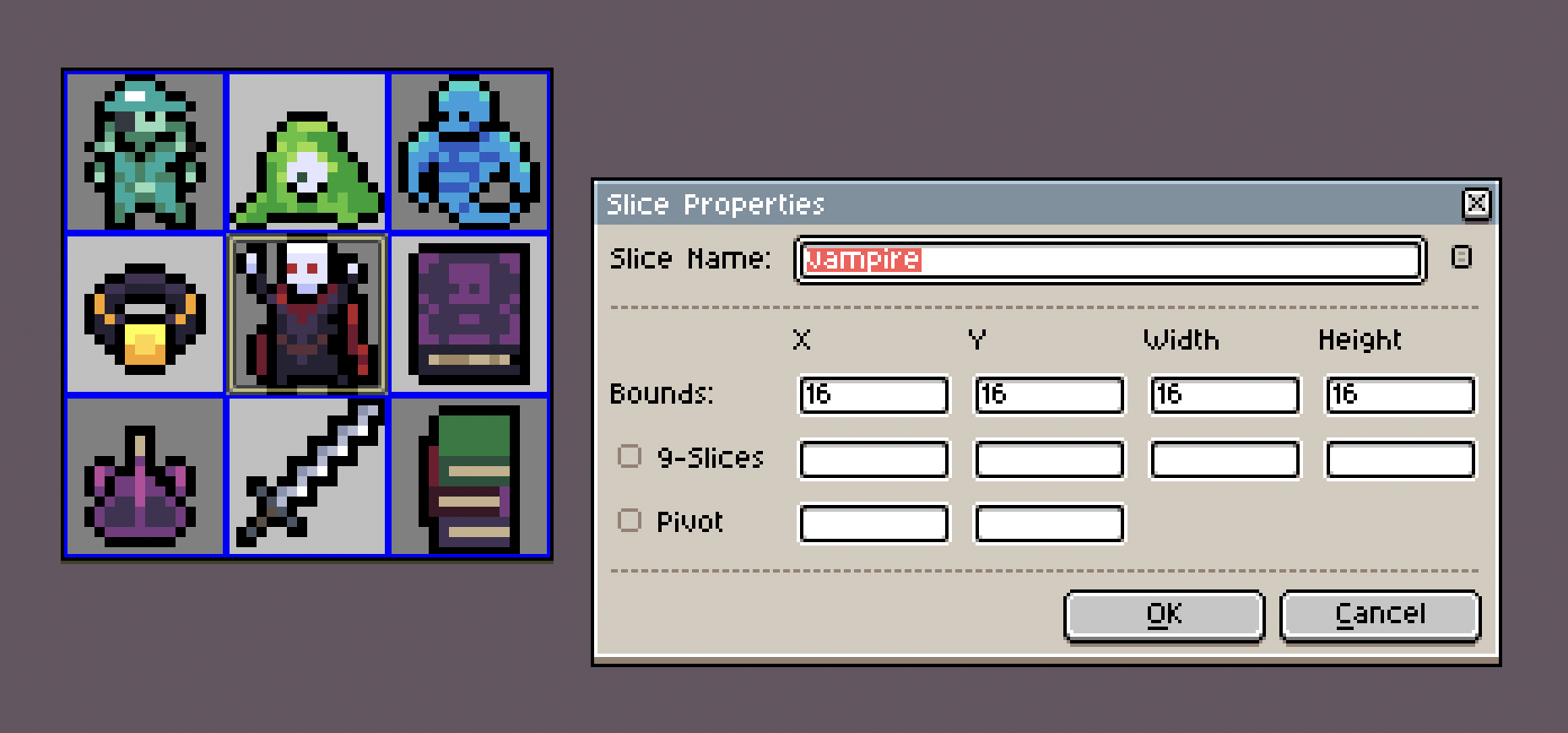Aseprite extension for generating TypeScript files from sprite slices.
Will export a TypeScript file like this:
// Generated by 'Export TypeScript Sprites' Aseprite Extension
import url from "./sprites.png"
export const pirate = { url, y: 0, h: 16, w: 16, x: 0, };
export const slime = { url, y: 0, h: 16, w: 16, x: 16, };
export const djinn = { url, y: 0, h: 16, w: 16, x: 32, };
export const ring = { url, y: 16, h: 16, w: 16, x: 0, };
export const vampire = { url, y: 16, h: 16, w: 16, x: 16, };
export const necronomicon = { url, y: 16, h: 16, w: 16, x: 32, };
export const potion = { url, y: 32, h: 16, w: 16, x: 0, };
export const flamberge = { url, y: 32, h: 16, w: 16, x: 16, };
export const books = { url, y: 32, h: 16, w: 16, x: 32, };Then you can reference these sprites with full type safety. Deleting or renaming a sprite creates a verifiable type error.
import * as sprites from "./sprites.ts";
sprites.imp
// ^^^
// Property 'imp' does not exist ...Aseprite already supports a JSON export, but it's awkward to consume.
{ "frames": {
"sprites.aseprite": {
"frame": { "x": 0, "y": 0, "w": 48, "h": 48 },
"rotated": false,
"trimmed": false,
"spriteSourceSize": { "x": 0, "y": 0, "w": 48, "h": 48 },
"sourceSize": { "w": 48, "h": 48 },
"duration": 100
}
},
"meta": {
"app": "https://www.aseprite.org/",
"version": "1.3-beta21-arm64",
"image": "sprites.png",
"format": "RGBA8888",
"size": { "w": 48, "h": 48 },
"scale": "1",
"frameTags": [
],
"layers": [
{ "name": "Layer 1", "opacity": 255, "blendMode": "normal" }
],
"slices": [
{ "name": "dread_pirate", "color": "#0000ffff", "keys": [{ "frame": 0, "bounds": {"x": 0, "y": 0, "w": 16, "h": 16 } }] },
{ "name": "slime", "color": "#0000ffff", "keys": [{ "frame": 0, "bounds": {"x": 16, "y": 0, "w": 16, "h": 16 } }] },
{ "name": "djinn", "color": "#0000ffff", "keys": [{ "frame": 0, "bounds": {"x": 32, "y": 0, "w": 16, "h": 16 } }] },
{ "name": "ring", "color": "#0000ffff", "keys": [{ "frame": 0, "bounds": {"x": 0, "y": 16, "w": 16, "h": 16 } }] },
{ "name": "vampire", "color": "#0000ffff", "keys": [{ "frame": 0, "bounds": {"x": 16, "y": 16, "w": 16, "h": 16 } }] },
{ "name": "necronomicon", "color": "#0000ffff", "keys": [{ "frame": 0, "bounds": {"x": 32, "y": 16, "w": 16, "h": 16 } }] },
{ "name": "potion", "color": "#0000ffff", "keys": [{ "frame": 0, "bounds": {"x": 0, "y": 32, "w": 16, "h": 16 } }] },
{ "name": "flamberge", "color": "#0000ffff", "keys": [{ "frame": 0, "bounds": {"x": 16, "y": 32, "w": 16, "h": 16 } }] },
{ "name": "books", "color": "#0000ffff", "keys": [{ "frame": 0, "bounds": {"x": 32, "y": 32, "w": 16, "h": 16 } }] }
]
}
}Even with resolveJsonModule it's not possible to do the equivalent of as const with a JSON import, meaning that the sprites names are always generalised as string in the resolved type.
Grab the extension from the latest release and install it.
Then you can either press ⌘ ⇧ E or go to "File > Export TypeScript" to export the active sprite to PNG and TS files next to the Asesprite file.
For example, if you have the following file structure:
src/
sprites.aseprite
After exporting, you will have:
src/
sprites.aseprite
sprites.ts
sprites.png
Sprites that have defined a pivot point will export it.
export const door = { url, y: 16, h: 16, w: 16, x: 0, pivot: { x: 0, y: 16 } };Sprites that have defined a 9 slice will export it.
export const panel = { url, y: 16, h: 16, w: 16, x: 0, center: { x: 1, y: 1, w: 14, h: 14 } };center is the central rectangle of the 9 slice, and you can use it to infer the other 8 rectangles.
- Slice names that start with numbers, or collide with reserved words in JavaScript will be prefixed with an
_. For example a slice called9_headed_hydrawould becomeexport const _9_headed_hydra. - It's not possible to control the PNG part of the export with any of the options you're used to seeing with a conventional sprite export. All layers are exported and it will always export at 1x resolution with no border padding or spacing.
- It's not possible to control the export destination of the resulting PNG and TS files. They will always export next to the source
.asepritefile.
